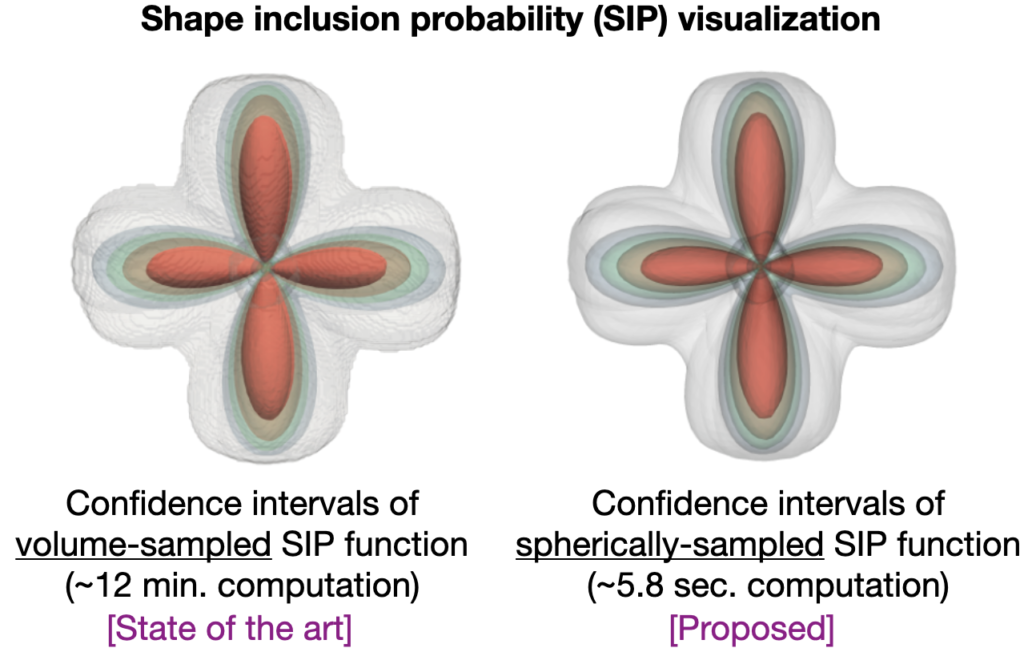
HARDI Uncertainty Quantification and Visualization with Spherical Sampling
T. Patel, T. M. Athawale, T. Ouermi, and Chris R. Johnson
[Preprint (coming soon)]`
(To Appear in Computer Graphics Forum (CGF), Special Issue on EuroVis 2025 Conf. (Luxembourg city, Luxembourg))
AbstractIn this paper, we study uncertainty quantification and visualization of orientation distribution functions (ODF), which corresponds to the diffusion profile of high angular resolution diffusion imaging (HARDI) data. The shape inclusion probability (SIP) function is the state-of-the-art method for capturing the uncertainty of ODF ensembles. The current method of computing the SIP function with a volumetric basis exhibits high computational and memory costs, which can be a bottleneck to integrating uncertainty into HARDI visualization techniques and tools. We propose a novel spherical sampling framework for faster computation of the SIP function with lower memory usage and increased accuracy. In particular, we propose direct extraction of SIP isosurfaces, which represent confidence intervals indicating spatial uncertainty of HARDI glyphs, by performing spherical sampling of ODFs. Our spherical sampling approach requires much less sampling than the state-of-the-art volume sampling method, thus providing significantly enhanced performance, scalability, and the ability to perform implicit ray tracing. Our experiments demonstrate that the SIP isosurfaces extracted with our spherical sampling approach can achieve up to 8164X speedup, 37282X memory reduction, and 50.2% less SIP isosurface error compared to the classical volume sampling approach. We demonstrate the efficacy of our methods through experiments on synthetic and human-brain HARDI datasets.
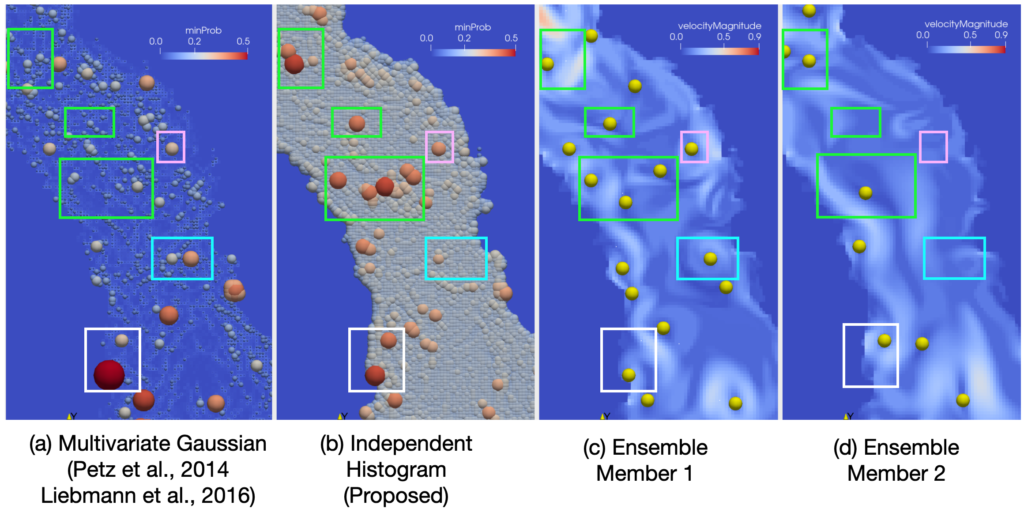 Uncertainty Visualization of Critical Points of 2D Scalar Fields for Parametric and Nonparametric Probabilistic Models
Uncertainty Visualization of Critical Points of 2D Scalar Fields for Parametric and Nonparametric Probabilistic Models
T. M. Athawale, Z. Wang, D. Pugmire, K. Moreland, Q. Gong, S. Klasky, C. R. Johnson, and P. Rosen
[Preprint (arXiv), Supplementary material] [Preview Video] [Presentation Video] [Presentation slides] [Code]
(IEEE Transactions on Visualization and Computer Graphics (TVCG), Special Issue on 2024 IEEE VIS Conf. (St. Pete Beach, USA), vol. 31, no. 1, pp. 108-118, Jan. 2025)
AbstractThis paper presents a novel end-to-end framework for closed-form computation and visualization of critical point uncertainty in 2D uncertain scalar fields. Critical points are fundamental topological descriptors used in the visualization and analysis of scalar fields. The uncertainty inherent in data (e.g., observational and experimental data, approximations in simulations, and compression), however, creates uncertainty regarding critical point positions. Uncertainty in critical point positions, therefore, cannot be ignored, given their impact on downstream data analysis tasks. In this work, we study uncertainty in critical points as a function of uncertainty in data modeled with probability distributions. Although Monte Carlo (MC) sampling techniques have been used in prior studies to quantify critical point uncertainty, they are often expensive and are infrequently used in production-quality visualization software. We, therefore, propose a new end-to-end framework to address these challenges that comprises a threefold contribution. First, we derive the critical point uncertainty in closed form, which is more accurate and efficient than the conventional MC sampling methods. Specifically, we provide the closed-form and semianalytical (a mix of closed-form and MC methods) solutions for parametric (e.g., uniform, Epanechnikov) and nonparametric models (e.g., histograms) with finite support. Second, we accelerate critical point probability computations using a parallel implementation with the VTK-m library, which is platform portable. Finally, we demonstrate the integration of our implementation with the ParaView software system to demonstrate near-real-time results for real datasets.
 Visualization at Exascale: Making It All Work With VTK-m
Visualization at Exascale: Making It All Work With VTK-m
K. Moreland, T. M. Athawale, V. Bolea, M. Bolstad, E. Brugger, H. Childs, A. Huebl, L.-T. Lo, B. Geveci, N. Marsaglia, S. Philip, D. Pugmire, S. Rizzi, Z. Wang, and A. Yenpure
[Preprint]
(The International Journal of High Performance Computing Applications, vol. 38, no. 5., pp. 508-526, 2024)
AbstractThe VTK-m software library enables scientific visualization on exascale-class supercomputers. Exascale machines are particularly challenging for software development in part because they use GPU accelerators to provide the vast majority of their computational throughput. Algorithmic designs for GPUs and GPU-centric computing often deviate from those that worked well on previous generations of high-performance computers that relied on traditional CPUs. Fortunately, VTK-m provides scientific visualization algorithms for GPUs and other accelerators. VTK-m also provides a framework that simplifies the implementation of new algorithms and adds a porting layer to work across multiple processor types. This paper describes the main challenges encountered when making scientific visualization available at exascale. We document the surprises and obstacles faced when moving from pre-exascale platforms to the final exascale designs and the performance on those systems including scaling studies on Frontier, an exascale machine with over 37,000 AMD GPUs. We also report on the integration of VTK-m with other exascale software technologies. Finally, we show how VTK-m helps scientific discovery for applications such as fusion and particle acceleration that leverage an exascale supercomputer.
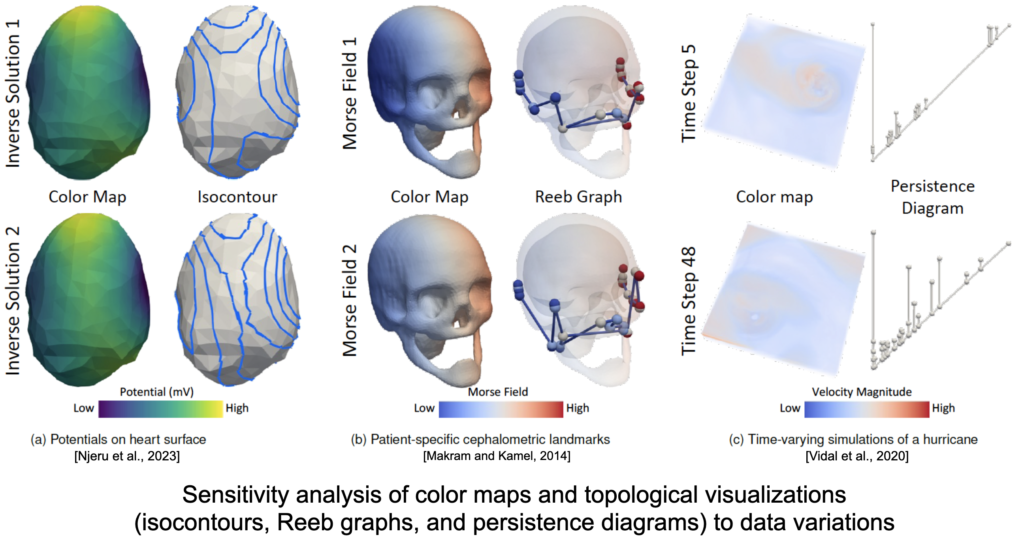 A Comparative Study of the Perceptual Sensitivity of Topological Visualizations to Feature Variations
A Comparative Study of the Perceptual Sensitivity of Topological Visualizations to Feature Variations
T. M. Athawale, B. Triana, T. Kotha, D. Pugmire, and P. Rosen
[Preprint (arXiv), supplementary material] [bibTex] [Preview video] [Presentation video] [Presentation slides]
(IEEE Transactions on Visualization and Computer Graphics (TVCG), Special Issue on 2023 IEEE VIS Conf. (Melbourne, Australia), vol. 30, no. 1, pp. 1074-1084, Jan., 2024)
AbstractColor maps are a commonly used visualization technique in which data are mapped to optical properties, e.g., color or opacity. Color maps, however, do not explicitly convey structures (e.g., positions and scale of features) within data. Topology-based visualizations reveal and explicitly communicate structures underlying data. Although we have a good understanding of what types of features are captured by topological visualizations, our understanding of people's perception of those features is not. This paper evaluates the sensitivity of topology-based isocontour, Reeb graph, and persistence diagram visualizations compared to a reference color map visualization for synthetically generated scalar fields on 2-manifold triangular meshes embedded in 3D. In particular, we built and ran a human-subject study that evaluated the perception of data features characterized by Gaussian signals and measured how effectively each visualization technique portrays variations of data features arising from the position and amplitude variation of a mixture of Gaussians. For positional feature variations, the results showed that only the Reeb graph visualization had high sensitivity. For amplitude feature variations, persistence diagrams and color maps demonstrated the highest sensitivity, whereas isocontours showed only weak sensitivity. These results take an important step toward understanding which topology-based tools are best for various data and task scenarios and their effectiveness in conveying topological variations as compared to conventional color mapping.
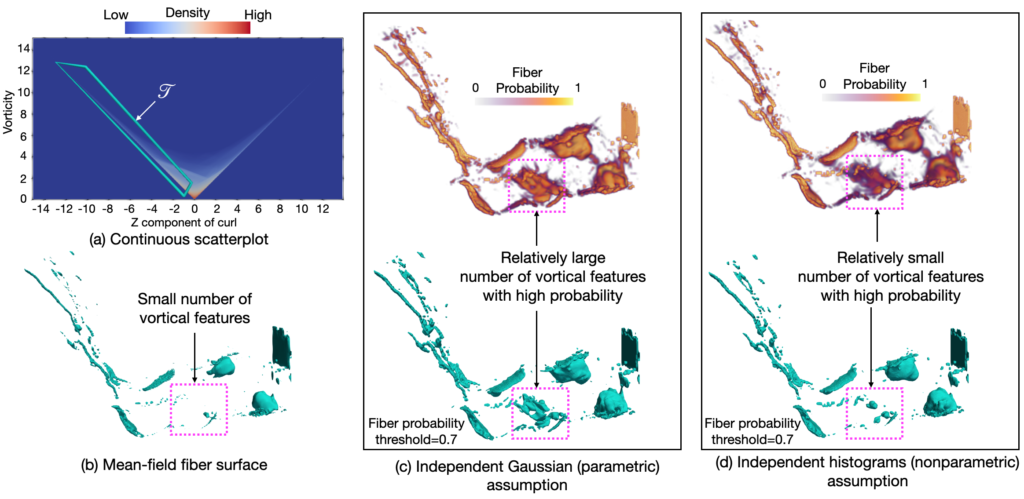 Fiber Uncertainty Visualization for Bivariate Data With Parametric and Nonparametric Noise Models
Fiber Uncertainty Visualization for Bivariate Data With Parametric and Nonparametric Noise Models
T. M. Athawale, C. R. Johnson, S. Sane, and D. Pugmire
[Preprint (arXiv), Supplementary material] [BibTex] [Preview video] [Presentation video] [Presentation slides]
(IEEE Transactions on Visualization and Computer Graphics (TVCG), Special Issue on 2022 IEEE VIS Conf. (Oklahoma, USA), vol. 29, no. 1, pp. 613-623, Jan. 2023.)
AbstractVisualization and analysis of multivariate data and their uncertainty are top research challenges in data visualization. Constructing fiber surfaces is a popular technique for multivariate data visualization that generalizes the idea of level-set visualization for univariate data to multivariate data. In this paper, we present a statistical framework to quantify positional probabilities of fibers extracted from uncertain bivariate fields. Specifically, we extend the state-of-the-art Gaussian models of uncertainty for bivariate data to other parametric distributions (e.g., uniform and Epanechnikov) and more general nonparametric probability distributions (e.g., histograms and kernel density estimation) and derive corresponding spatial probabilities of fibers. In our proposed framework, we leverage Green's theorem for closed-form computation of fiber probabilities when bivariate data are assumed to have independent parametric and nonparametric noise. Additionally, we present a nonparametric approach combined with numerical integration to study the positional probability of fibers when bivariate data are assumed to have correlated noise. For uncertainty analysis, we visualize the derived probability volumes for fibers via volume rendering and extracting level sets based on probability thresholds. We present the utility of our proposed techniques via experiments on synthetic and simulation datasets.
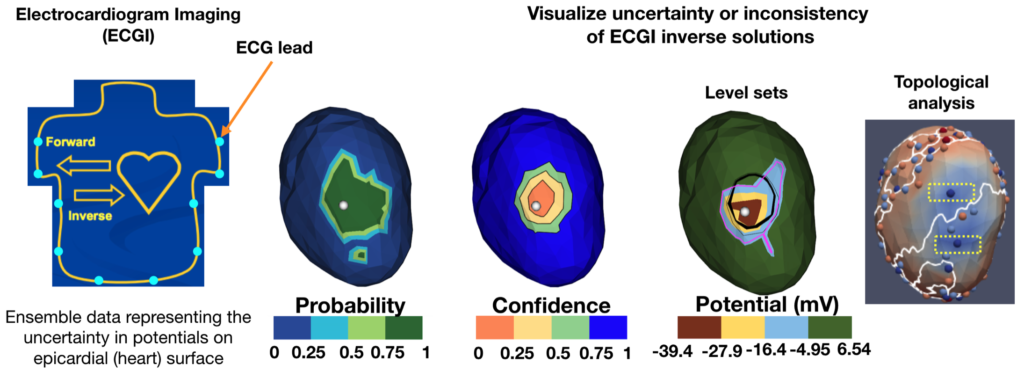 Quantifying and Visualizing Uncertainty for Source Localization in Electrocardiographic Imaging
Quantifying and Visualizing Uncertainty for Source Localization in Electrocardiographic Imaging
D. Njeru, T. M. Athawale, J. France, and C. R. Johnson
[Preprint (bioRxiv)] [BibTex]
(Computer Methods in Biomechanics and Biomedical Engineering: Imaging and Visualization (CMBBE), vol. 11, no. 3, pp. 812-822, 2023.)
AbstractElectrocardiographic imaging (ECGI) presents a clinical opportunity to noninvasively understand the sources of arrhythmias for individual patients. To help increase the effectiveness of ECGI, we provide new ways to visualize associated measurement and modeling errors. In this paper, we study source localization uncertainty in two steps: First, we perform Monte Carlo simulations of a simple inverse ECGI source localization model with error sampling to understand the variations in ECGI solutions. Second, we present multiple visualization techniques, including confidence maps, level-sets, and topology-based visualizations, to better understand uncertainty in source localization. Our approach offers a new way to study uncertainty in the ECGI pipeline.
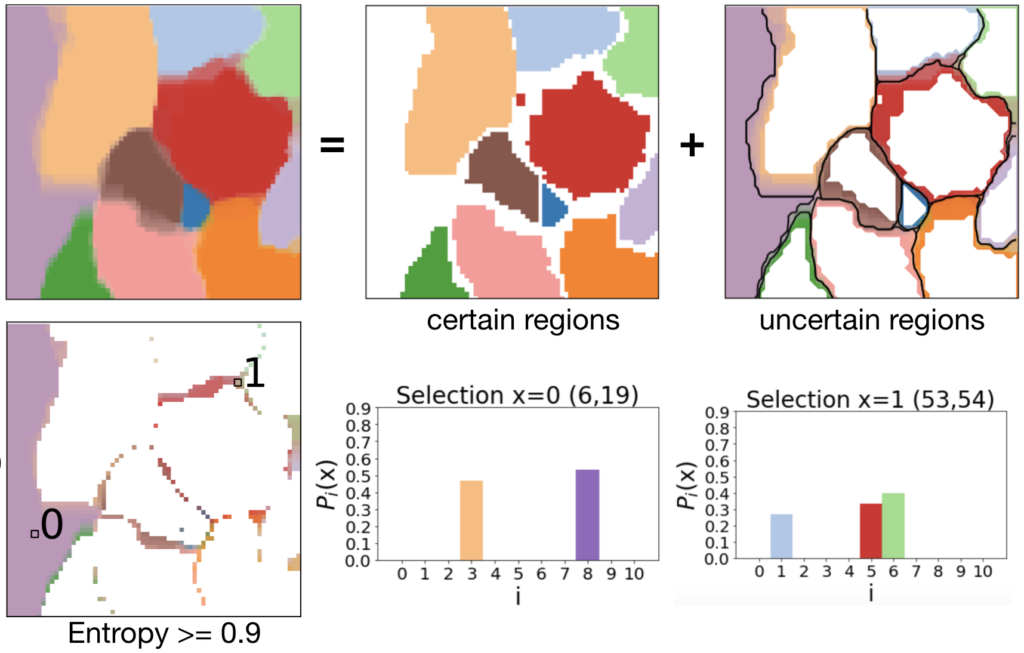 Uncertainty Visualization of 2D Morse Complex Ensembles Using Statistical Summary Maps
Uncertainty Visualization of 2D Morse Complex Ensembles Using Statistical Summary Maps
T. M. Athawale, D. Maljovec, L. Yan, C. R. Johnson, V. Pascucci, and B. Wang
[Preprint, Supplementary material] [BibTex] [Preview video] [PubMed] [Presentation slides] [Presentation video (VIS 2020 uncertainty session, talk# 2)]
(IEEE Transactions on Visualization and Computer Graphics (TVCG), vol. 28, no. 4, pp. 1955-1966, 2022.)
AbstractMorse complexes are gradient-based topological descriptors with close connections to Morse theory. They are widely applicable in scientific visualization as they serve as important abstractions for gaining insights into the topology of scalar fields. Data uncertainty inherent to scalar fields due to randomness in their acquisition and processing, however, limits our understanding of Morse complexes as structural abstractions. We, therefore, explore uncertainty visualization of an ensemble of 2D Morse complexes that arises from scalar fields coupled with data uncertainty. We propose several statistical summary maps as new entities for quantifying structural variations and visualizing positional uncertainties of Morse complexes in ensembles. Specifically, we introduce three types of statistical summary maps -- the probabilistic map, the significance map, and the survival map -- to characterize the uncertain behaviors of gradient flows. We demonstrate the utility of our proposed approach using wind, flow, and ocean eddy simulation datasets.

Direct Volume Rendering with Nonparametric Models of Uncertainty
T. M. Athawale, B. Ma, E. Sakhaee, C. R. Johnson, and A. Entezari
[Preprint, Supplementary material] [BibTex] [Preview video] [Presentation slides] [Presentation video (VIS 2020 uncertainty session, talk# 1)]
(IEEE Transactions on Visualization and Computer Graphics (TVCG), Special Issue on 2020 IEEE VIS Conf. (Virtual), vol. 27, no. 2, pp. 1797-1807, Feb. 2021.)
AbstractWe present a nonparametric statistical framework for the quantification, analysis, and propagation of data uncertainty in direct volume rendering (DVR). The state-of-the-art statistical DVR framework allows for preserving the transfer function (TF) of the ground truth function when visualizing uncertain data; however, the existing framework is restricted to parametric models of uncertainty. In this paper, we address the limitations of the existing DVR framework by extending the DVR framework for nonparametric distributions. We exploit the quantile interpolation technique to derive probability distributions representing uncertainty in viewing-ray sample intensities in closed form, which allows for accurate and efficient computation. We evaluate our proposed nonparametric statistical models through qualitative and quantitative comparisons with the mean-field and parametric statistical models, such as uniform and Gaussian, as well as Gaussian mixtures. In addition, we present an extension of the state-of-the-art rendering parametric framework to 2D TFs for improved DVR classifications. We show the applicability of our uncertainty quantification framework to ensemble, downsampled, and bivariate versions of scalar field datasets.

Probabilistic Asymptotic Decider for Topological Ambiguity Resolution in Level-Set Extraction for Uncertain 2D Data
T. M. Athawale and C. R. Johnson
[Preprint,Appendix1,Appendix2] [BibTex] [Preview video] [PubMed] [Presentation slides] [Presentation video] [Source Code (MATLAB)]
(IEEE Transactions on Visualization and Computer Graphics (TVCG), Special Issue on 2018 IEEE VIS Conf. (Berlin, Germany), vol. 25, no. 1, pp. 1163-1172, Jan. 2019.)
AbstractWe present a framework for the analysis of uncertainty in isocontour extraction. The marching squares (MS) algorithm for isocontour reconstruction generates a linear topology that is consistent with hyperbolic curves of a piecewise bilinear interpolation. The saddle points of the bilinear interpolant cause topological ambiguity in isocontour extraction. The midpoint decider and the asymptotic decider are well-known mathematical techniques for resolving topological ambiguities. The latter technique investigates the data values at the cell saddle points for ambiguity resolution. The uncertainty in data, however, leads to uncertainty in underlying bilinear interpolation functions for the MS algorithm, and hence, their saddle points. In our work, we study the behavior of the asymptotic decider when data at grid vertices is uncertain. First, we derive closed-form distributions characterizing variations in the saddle point values for uncertain bilinear interpolants. The derivation assumes uniform and nonparametric noise models, and it exploits the concept of ratio distribution for analytic formulations. Next, the probabilistic asymptotic decider is devised for ambiguity resolution in uncertain data using distributions of the saddle point values derived in the first step. Finally, the confidence in probabilistic topological decisions is visualized using a colormapping technique. We demonstrate the higher accuracy and stability of the probabilistic asymptotic decider in uncertain data with regard to existing decision frameworks, such as deciders in the mean field and the probabilistic midpoint decider, through the isocontour visualization of synthetic and real datasets.
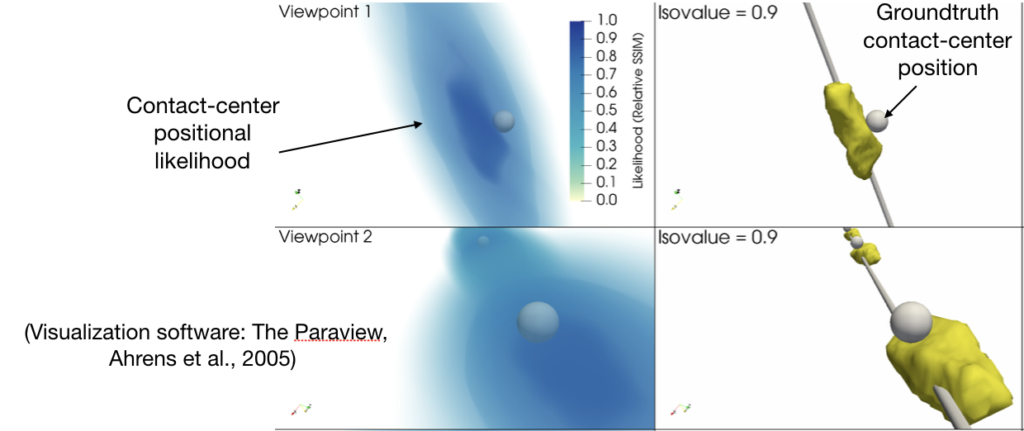
A Statistical Framework for Quantification and Visualization of Positional Uncertainty in Deep Brain Stimulation Electrodes
T. M. Athawale, K. A. Johnson, C. R. Butson, and C. R. Johnson
[Preprint] [BibTex] [PubMed] [Poster] [Source code (MATLAB)]
(Computer Methods in Biomechanics and Biomedical Engineering: Imaging & Visualization (CMBBE), vol. 7, no. 4, pp. 438-449, 2019.)
AbstractDeep brain stimulation (DBS) is an established therapy for treating patients with movement disorders such as Parkinson’s disease. Patient-specific computational modeling and visualization have been shown to play a key role in surgical and therapeutic decisions for DBS. The computational models use brain imaging, such as magnetic resonance (MR) and computed tomography (CT), to determine the DBS electrode positions within the patient’s head. The finite resolution of brain imaging, however, introduces uncertainty in electrode positions. The DBS stimulation settings for optimal patient response are sensitive to the relative positioning of DBS electrodes to a specific neural substrate (white/grey matter). In our contribution, we study positional uncertainty in the DBS electrodes for imaging with finite resolution. In a three-step approach, we first derive a closed-form mathematical model characterizing the geometry of the DBS electrodes. Second, we devise a statistical framework for quantifying the uncertainty in the positional attributes of the DBS electrodes, namely the direction of longitudinal axis and the contact-centre positions at subvoxel levels. The statistical framework leverages the analytical model derived in step one and a Bayesian probabilistic model for uncertainty quantification. Finally, the uncertainty in contact-centre positions is interactively visualized through volume rendering and isosurfacing techniques. We demonstrate the efficacy of our contribution through experiments on synthetic and real datasets. We show that the spatial variations in true electrode positions are significant for finite resolution imaging, and interactive visualization can be instrumental in exploring probabilistic positional variations in the DBS lead.
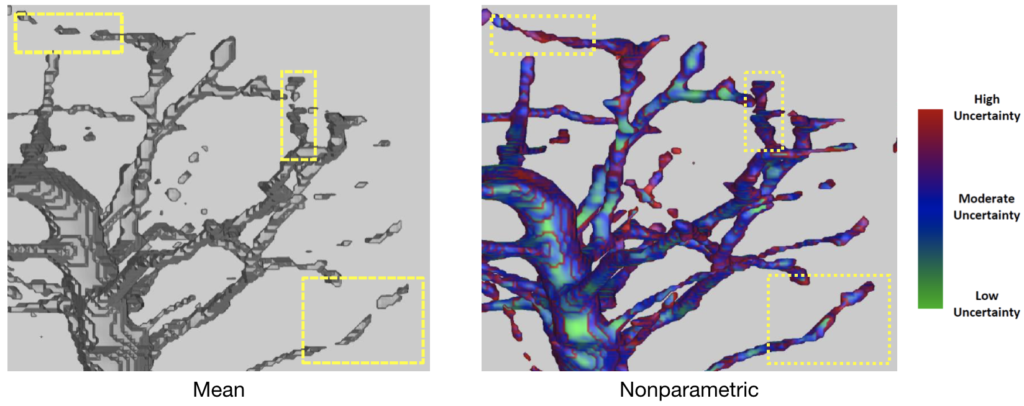
Isosurface Visualization of Data with Nonparametric Models for Uncertainty
T. M. Athawale, E. Sakhaee, and A. Entezari
[Preprint, Appendix] [BibTex] [Preview video] [PubMed] [Presentation slides] [Source code (C++, MATLAB)]
(IEEE Transactions on Visualization and Computer Graphics (TVCG), Special Issue on 2015 IEEE VIS Conf. (Chicago, USA), vol. 22, no. 1, pp. 777-786, Jan. 2016.)
AbstractThe problem of isosurface extraction in uncertain data is an important research problem and may be approached in two ways. One can extract statistics (e.g., mean) from uncertain data points and visualize the extracted field. Alternatively, data uncertainty, characterized by probability distributions, can be propagated through the isosurface extraction process. We analyze the impact of data uncertainty on topology and geometry extraction algorithms. A novel, edge-crossing probability based approach is proposed to predict underlying isosurface topology for uncertain data. We derive a probabilistic version of the midpoint decider that resolves ambiguities that arise in identifying topological configurations. Moreover, the probability density function characterizing positional uncertainty in isosurfaces is derived analytically for a broad class of nonparametric distributions. This analytic characterization can be used for efficient closed-form computation of the expected value and variation in geometry. Our experiments show the computational advantages of our analytic approach over Monte-Carlo sampling for characterizing positional uncertainty. We also show the advantage of modeling underlying error densities in a nonparametric statistical framework as opposed to a parametric statistical framework through our experiments on ensemble datasets and uncertain scalar fields.
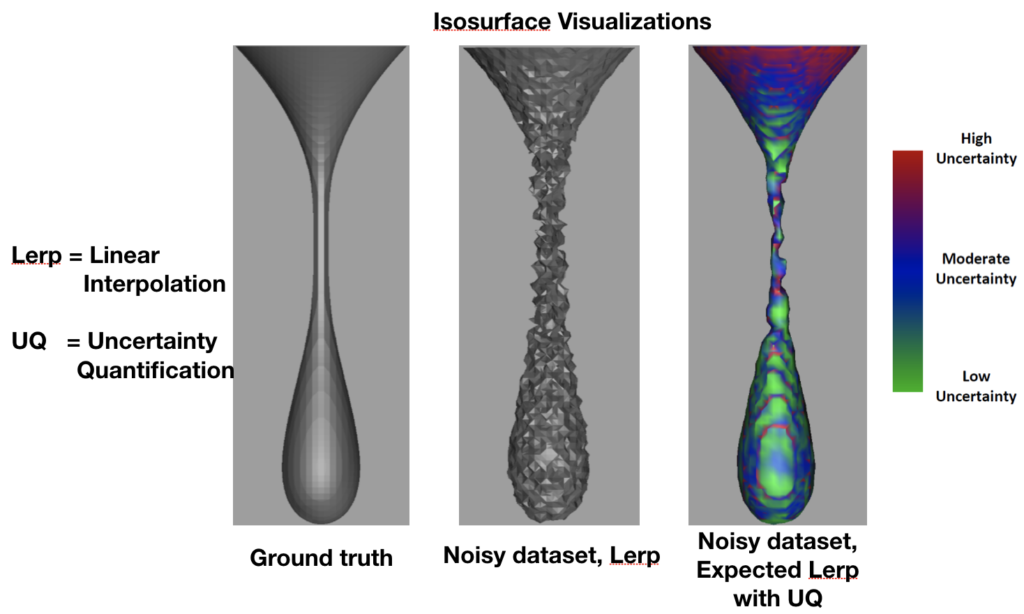
Uncertainty Quantification in Linear Interpolation for Isosurface Extraction
T. M. Athawale and A. Entezari
[Preprint, Appendix] [BibTex] [Preview video] [PubMed] [Presentation slides] [Source code (C++)]
(IEEE Transactions on Visualization and Computer Graphics (TVCG), Special Issue on 2013 IEEE VIS Conf. (Atlanta, USA), vol. 19, no. 12, pp. 2723-2732, Dec. 2013.)
AbstractWe present a study of linear interpolation when applied to uncertain data. Linear interpolation is a key step for isosurface extraction algorithms, and the uncertainties in the data lead to non-linear variations in the geometry of the extracted isosurface. We present an approach for deriving the probability density function of a random variable modeling the positional uncertainty in the isosurface extraction. When the uncertainty is quantified by a uniform distribution, our approach provides a closed-form characterization of the mentioned random variable. This allows us to derive, in closed form, the expected value as well as the variance of the level-crossing position. While the former quantity is used for constructing a stable isosurface for uncertain data, the latter is used for visualizing the positional uncertainties in the expected isosurface level crossings on the underlying grid.
 Uncertainty Visualization of Critical Points of 2D Scalar Fields for Parametric and Nonparametric Probabilistic Models
Uncertainty Visualization of Critical Points of 2D Scalar Fields for Parametric and Nonparametric Probabilistic Models Visualization at Exascale: Making It All Work With VTK-m
Visualization at Exascale: Making It All Work With VTK-m A Comparative Study of the Perceptual Sensitivity of Topological Visualizations to Feature Variations
A Comparative Study of the Perceptual Sensitivity of Topological Visualizations to Feature Variations Fiber Uncertainty Visualization for Bivariate Data With Parametric and Nonparametric Noise Models
Fiber Uncertainty Visualization for Bivariate Data With Parametric and Nonparametric Noise Models Quantifying and Visualizing Uncertainty for Source Localization in Electrocardiographic Imaging
Quantifying and Visualizing Uncertainty for Source Localization in Electrocardiographic Imaging Uncertainty Visualization of 2D Morse Complex Ensembles Using Statistical Summary Maps
Uncertainty Visualization of 2D Morse Complex Ensembles Using Statistical Summary Maps





